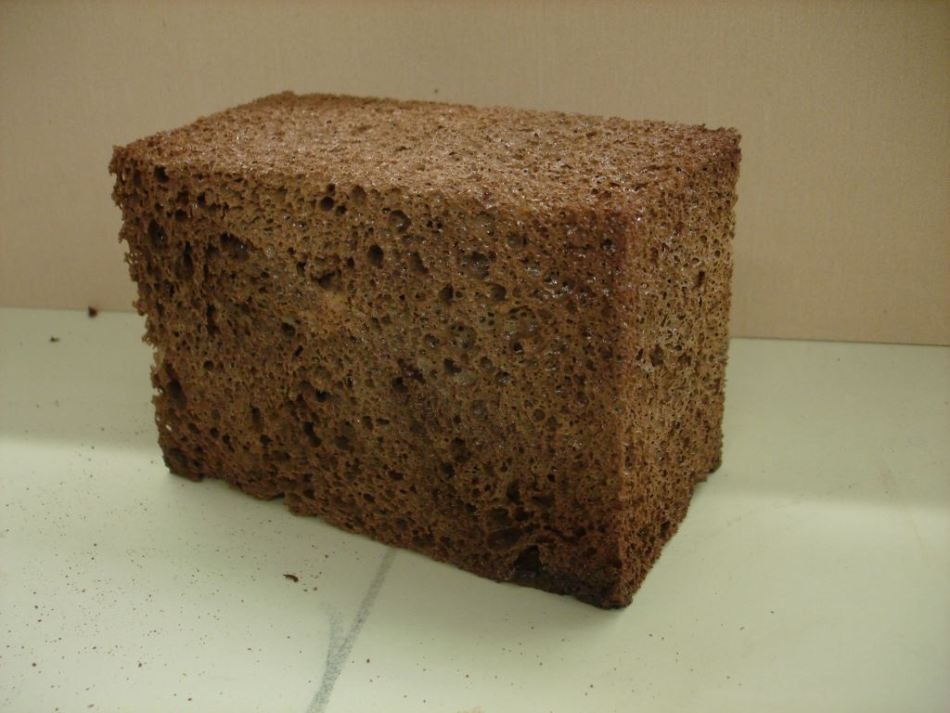Oct 25 2017
In the timber industry, the bark of native conifers is considered to be a waste product that is predominantly burnt or used as garden mulch. Researchers from the National Research Program “Resource Wood” (NRP 66) have devised an innovative technique for extracting useful tannins from the bark to make composite materials and adhesives.
 Tannin foam for lightweight construction and furniture-making. Credit: Swiss National Science Foundation
Tannin foam for lightweight construction and furniture-making. Credit: Swiss National Science Foundation
Tannins attract the attention of not only wine experts but they are also the focus of Swiss wood research. Frédéric Pichelin and his colleagues from the Bern University of Applied Sciences in Biel consider that barks of native trees have greater capabilities.
If we take cascaded use seriously, we need to find ways of using tree bark because the wood industry produces plenty of it. This offers new sources of income, based on a renewable resource, to saw mills and the manufacturing industry.
Frédéric Pichelin, the Bern University of Applied Sciences, Biel
Creating added value in Switzerland
Tannin extracts are already being used to produce wood adhesives. However, they are largely acquired from tropical wood and synthesized offshore, and barks of native conifers are not used in the commercial extraction of tannin. The Scientists from Biel were constantly looking to change this scenario by devising techniques for extracting tannins from barks of native trees and investigating their applicability in synthesizing adhesives for chipboards and fiberboards.
The Researchers adopted a two-stage water-based technique and managed to derive tannins with excellent purity. Then, they overcame the difficulty of formulating a process for transforming the extracts into adhesives for chipboards and fiberboards. The outcomes of their research look impressive—they added water to the spruce bark extracts to produce adhesives that can be applied for making the boards.
It is evident that the boards made at pilot level were produced without using formaldehyde— the agent usually used in glued wood products and has harmful impacts.
We are solving two problems in one go. We are replacing synthetic oil-based adhesives with products made from renewable resources, and we are getting rid of unhealthy emissions of commonly available fibreboards and chipboards.
Frédéric Pichelin, the Bern University of Applied Sciences, Biel
Working on the aim of industrial application, the team is at present moving forward with their concept of using tree bark. At the same time, they are constantly striving to achieve greater purity levels in the extracts from barks of native trees because usually used offshore tannins bring about marginally better outcomes with respect to the water resistance and solidity of glued wood products.
They expect to accomplish a product with high purity by devising superior extraction techniques. Moreover, they have to minimize the variability of tannin extraction yield and enhance the reproducibility. They have to be successful in both areas before applying the process for industrial production.
Tree bark extracts for 3D printing
Apart from being used to bind wood products, tannins extracted from tree barks are also being used to bind other fibrous materials. The Biel Scientists are of the view that tannin-based foams for boards can find additional applications in furniture-making and light construction. An extraordinary characteristic of tannin foams is their exceptional fire resistance, which renders them to be a sought-after products in fields in which fire prevention is of greatest importance.
Moreover, tannin extracts have a significant role in producing composite materials for 3D printing. The Scientists predict that in future, printable design and construction materials will be wholly or chiefly produced from bark and wood. Finally, the food and pharmaceutical industries are also exhibiting interest in tannins due to their antibacterial and antioxidant characteristics that are not definitely due to the tannins themselves but due to other components extracted from the bark. The components provide natural protection to trees against bacterial and fungal infections and may be prospectively applied for wood surface treatments.
The application potential of wood bark tannins is great. Presently it is difficult to say in which direction the development will go. What is important is that Switzerland is not left behind.
Frédéric Pichelin, the Bern University of Applied Sciences, Biel